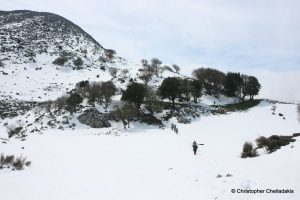The shelter of Tavri is located at an altitude of 1200m at the plateau of Tavri, by Askyfou. It can be access by walking 1:30 hours in the cypresswooded trail starting from village Ammoudari (or dricing a 7.5km long dirt track). From this refuge you can walk to Kastro peak, cross Sfakiano or Kavi Gorges.
The plateaus of Tavri and Niatos are located 2km and 3km west of Askifou Plateau, 51km south of Chania, at an altitude of 1200m. They can be accessed via a road starting from Askifou, crossing Tavri and then ending up in Niato.
Leon Cave was officially discovered on 11 August 2008 by a French-Greek team of speleologists, exploring the White Mountains of Chania (area Atzinolakos, near Melidoni of Fre municipality). However, its existence was known 15 years ago, during a French mission of the Catamaran Club. The area of Atzines has high speleological interest which has attracted mainly French, exploratory missions.
On the path that heads from the Amoutsera to the plateau of Katsiveli and peak Pachnes we meet the Rusies. This is a small plateau at an altitude of 2000 meters in the heart of the White Mountains and in the past years it was very important point for the people of the mountain, the Sfakians shepherds. The main reason for this was the cistern that gathered water and the small stone-built accommodation that served as a refuge in emergency times. The Plateau of Russies is located exactly between the peaks of Bournelos and Sternes.
In the central point of the massif of White Mountains we meet the peak Sternes with a maximum altitude of 2335 meters. This is the eighth highest peak of the White Mountains. The importance of Sternes is that it is located right in the center of the range, between a sea of peaks and thus from the top you can enjoy almost all the major peaks of the White Mountains.
Mega Oros (ie. big mountain) by Askyfou is one of the peaks of the eastern part of the White Mountains in the cluster of Agathes. It has an altitude of 1181 meters and is located near the location Akones, above Imbros. Mega Oros offers a unique view of the plateau Askyfou and the central core of the White Mountains on the west.
























































































